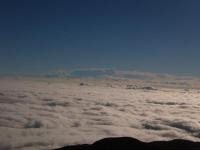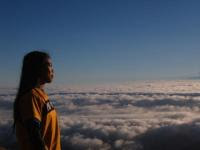Saturday, July 18, 2009
Why we Climb Mountains?
Many people outside of mountaineering cannot fathom why there are people who indulge in mountaineering. They cannot understand what can be derived from this activity which seemed to be "a waste of time, money, and energy." Moreover, they cannot think of a worthy reason why should people bring themselves to imminent danger when they can very well choose to stay away from it.
When asked, mountaineers usually reply, "Because it is fun and I love scaling it" or the more classical "Because it’s there." But scratch the surface and you will find one or all of the following reasons.
1.God, Nature, and Meditation
Mountaineering takes man away from the concrete jungle and back to his natural sanctuary. The mountain affords communing with nature. It is a place where man can walk in the clouds while smell the scent of wild plants and dew. The mountain orchestrates a symphony of streams and rampaging rivers, chorus of birds and crickets, and whistles of wind rustling through the trees. It blows a gentle breeze that touches the face, combs the hair, and enlivens the body. It empties the mind of worries and pours in peace that quiets the psyche and calms the restless nerves. Its ambience helps elevate consciousness to a higher plane to enable man to touch base with himself and his Creator. As he descends the mountain, he brings with him a renewed spirit, a clear mind, and a revitalized body.
2.Conquering Fears
Many presume that mountains keep a plethora of dangers. It boasts of venomous snakes and wild boars, steep cliffs, paranormal elements, and eerie, deafening silence. To some, they trigger fear. Only a few dare to face and conquer these phobias. And only a handful of these daredevils confront and resolve them through mountaineering. But no matter how long, little by little, mountaineering helps them conquer their fears.
3.Escape
There are some people who cannot stand continuous exposure to noise, congestion, technology, work, boredom, and problems in their urban lives. The mountain becomes an attractive destination to get away from their mundane situations, even temporarily. Sometimes, these mountain respites become their sole means of getting by without snapping off in their problematic and weary lives.
4.Travel
Mountaineering affords people to see new places and learn new culture at a very reasonable budget because accommodation cost is almost defrayed. Because mountains are interspersed throughout the archipelago, mountaineers travel from their home base to the location of the mountain that they want to climb.
5.Relationships
Mountaineers cannot help but forge sound relationships while in expedition. Friendship is built on solid grounds because they are founded in trust and care that are molded by unique situations and conditions in the mountain. A mountaineer learns to entrust his welfare and safety with his companion, to share his food, equipment, and other provisions, and to strip himself of pretenses and open his humble self to others. Sometimes, mountaineering brokers marriage out of these friendships.
6.Growth and Skills
Mountaineering requires people to at least know some basic skills. These skills are not only read but continually applied and honed each expedition. People become confident with their first aid skills, cooking, backpacking, leadership, and time management, to mention a few.
In addition, due to exposure to people, places, and culture, mountaineers build their character and become well-rounded individuals. They learn to be patient and enduring, disciplined and time-conscious, and courteous and considerate, among many other values.
7.Physical Fitness
Mountaineering is a very physical activity to engage in. Mountaineers oblige themselves with exercises for days before they climb. They build their endurance to prepare for the lengthy trek with a heavy pack at their back. They discipline their water intake, breathing patterns, and resting postures. They watch what they eat and take vitamin supplements for nutrition and energy needs.
8.Camping
A substantial portion of mountaineers had scouting experience when they were still in school. They are avid campers who loved campfires, hiking, swimming, and the many interesting gadgets that go with backpacking. Their outdoor bug stirs their interest even after school to continue camping. Their thirst for camping is quenched by mountaineering.
9.Cost Effective Hobby
Mountaineering may appear to be a costly hobby due to specialized gadgets and equipment that necessitate convenience and comfort in the outdoors. At the onset, it may seem to be expensive. And it is so because you accumulate mountaineering gears and equipment. However, if you take extra care of these specialty goods, they will be useful for many years. And if you calculate the purchase price of these goods and divide it by the number of years you were able to use them, you would be amazed to discover how negligible the amortized monthly expense is. The benefits you derive from mountaineering are exponentially higher than the aggregate amount of transportation and food expenses you would have to shell out every expedition.
10.Research and Education
There are people who indulge in mountaineering because their work or profession requires them to do so. Foresters, geologists, mountain rangers, journalists, and researchers study and explore the mountains because their work requires them to.
Wednesday, July 15, 2009
The Philippine Geographical Background
THE PHILIPPINE ISLANDS GEOGRAPHICAL BACKGROUND
The
The
The
THE RICHNESS OF THE PHILIPPINE LAND
The "
As it is situated in the earthquake belt of the Pacific, the country is rocked from time to time by seismic tremors and volcanic eruptions. The Philippine Fault, the biggest of its seismic faults, runs from Luzon to
The country has rich deposits of gold, silver, copper, and many other expensive metals and minerals. It has the biggest deposit of chromite, the largest deposit of nickel and one of the richest undeveloped iron ore deposits in the world. Gold, silver and other precious stones have been found all over the country in enormous amounts.
The Philippine climate is one of the best tropical climates in the world. In fact, it is one place on earth where flowers bloom all year round. There are only two seasons, the dry and the wet. March to June is the dry season. It is humid but tolerable. The average daytime temperature is at 30 to 35 degrees centigrade. The wet season is from June to October. Strong winds and heavy rains visit the islands of the
THE RICHNESS OF THE PHILIPPINE FORESTS
The Philippine forests boast of its rich flora and fauna. It is a haven for almost 4,000 species of trees, about 10,000 species of flowering plants and ferns, 580 species of birds, and 25,000 species of insects. The biggest Philippine bird, Sharpe’s Crane (Cruz antigone sharpei) is almost as tall as a man. The monkey-eating eagle, found in the jungles of
THE RICHNESS OF THE
More than 2,000 species of fish are found in the Philippine waters. Both the biggest and the smallest fish in the world are found in the waters of the
It is said that close to twenty percent of the worlds more than 60,000 species of shells can be found in the archipelago. Not surprisingly, the rarest shell (Connus gloriamaris), the smallest (Pisidum) and the largest (Tridacna gigas) shell, are all found in the Philippine waters. Philippine pearls are also considered among the finest in the worlds. The largest pearl in the world, known as the "Pearl of Allah," measuring more than 22.86 centimeters long and 12.7 centimeters in diameter and weighing 6.3 kilograms was found by a Filipino diver in the
THE RICH WONDERS OF THE
Endowed with a variety of natural wonders, the
These natural wonders are some of the reasons that enchant many foreign tourists to the
THE RICHNESS OF THE FILIPINOS AND THEIR CULTURE
Geographically, the
Predominantly Asian in race, Filipinos are a mixture of various race. The most dominant of which is the Malay race. Then there are the Indonesian, Chinese, Negrito, Spanish, Indian, and the American. The
There are eight major native languages and more than 100 dialects spoken all over the country. The Tagalog–based Filipino is the national language, spoken by the majority of the population. Cebuano is widely used in the Visayas and












